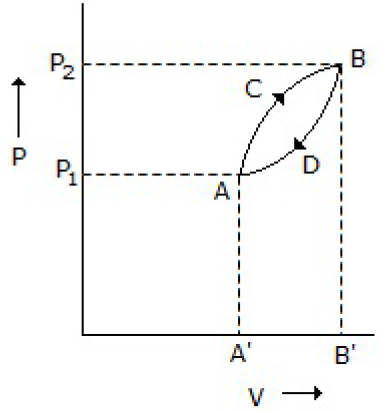Which of the following is not affected by temperature changes?
Fugacity
Activity co-efficient
Free energy
None of these
Correct Answer :
D. None of these
Related Questions
A solid metallic block weighing 5 kg has an initial temperature of 500°C. 40 kg of water initially at 25°C is contained in a perfectly insulated tank. The metallic block is brought into contact with water. Both of them come to equilibrium. Specific heat of block material is 0.4 kJ.kg-1. K-1. Ignoring the effect of expansion and contraction and also the heat capacity to tank, the total entropy change in kJ.kg-1, K-1 is
-1.87
0
1.26
3.91
First law of thermodynamics deals with the
Direction of energy transfer
Reversible processes only
Irreversible processes only
None of these
Heat pump
Accomplishes only space heating in winter
Accomplishes only space cooling in summer
Accomplishes both (A) and (B)
Works on Carnot cycle
Work done is a
Property of the system
Path function
Point function
State description of a system
The internal energy of an ideal gas is a function of its __________ only.
Molecular size
Volume
Pressure
Temperature
A change in state involving a decrease in entropy can be spontaneous, only if
It is exothermic
It is isenthalpic
It takes place isothermally
It takes place at constant volume
The equation Tds = dE - PdV applies to
Single phase fluid of varying composition
Single phase fluid of constant composition
Open as well as closed systems
Both (B) and (C)
Which of the following is Virial equation of state?
(p + a/V2)(V - b) = nRT
PV = nRT
PV = A + B/V + C/V2 + D/V3 + ...
None of these
Pick out the correct statement:
In an isothermal system, irreversible work is more than reversible work
Under reversible conditions, the adiabatic work is less than isothermal work
Heat, work, enthalpy and entropy are all 'state functions'
Matter and energy cannot be exchanged with the surroundings in a closed system
The necessary and sufficient condition for equilibrium between two phases is
The concentration of each component should be same in the two phases
The temperature of each phase should be same
The pressure should be same in the two phases
The chemical potential of each component should be same in the two phases
At the absolute zero temperature, the entropy of every perfectly crystalline substance becomes zero. This follows from the
Third law of thermodynamics
Second law of thermodynamics
Nernst heat theorem
Maxwell's relations
Which of the following has the minimum value of COP for a given refrigeration effect?
Reverse Carnot cycle
Ordinary vapour-compression cycle
Vapour-compression process with a reversible expansion engine
Air refrigeration cycle
The reaction A (l) → R(g) is allowed to reach equilibrium conditions in an autoclave. At equilibrium, there are two phases, one a pure liquid phase of A and the other a vapor phase of A, R and S. Initially A alone is present. The numbers of degrees of freedom are:
1
2
3
0
The chemical potential of any constituent of an ideal solution depends on the __________ of the solution.
Temperature
Pressure
Composition
All (A), (B) and (C)
Helmholtz free energy (A) is defined as
A = H - TS
A = E - TS
A = H + TS
None of these
Entropy change in case of reversible adiabatic process is
Minimum
Zero
Maximum
Indeterminate
In an isothermal process on an ideal gas, the pressure increases by 0.5 percent. The volume decreases by about __________ percent.
0.25
0.5
0.75
1
The co-efficient of performance (COP) of a refrigerating system, which is its index of performance, is defined as the ratio of useful refrigeration to the net work. The units of __________ and COP are the same.
Kinematic viscosity
Work
Temperature
None of these
If atmospheric temperature and dew point are nearly equal, then the relative humidity is
Zero
50%
Almost 100%
unpredictable
Lowering of condenser temperature (keeping the evaporator temperature constant) in case of vapour compression refrigeration system results in
Increased COP
Same COP
Decreased COP
Increased or decreased COP; depending upon the type of refrigerant
Those solutions in which there is no volume change upon mixing the components in the liquid state and which, when diluted do not undergo any heat change (i.e. heat of dilution is zero), are called __________ solutions.
Ideal
Real
Isotonic
None of these
Which of the following decreases with increase in pressure?
Melting point of ice
Melting point of wax
Boiling point of liquids
None of these
For spontaneous changes in an isolated system (S = entropy)
ds = 0
ds <0
ds > 0
ds = Constant
In the decomposition of PCl5 represented by, PCl5 PCl3 + Cl2, decrease in the pressure of the system will __________ the degree of dissociation of PCl5.
Increase
Decrease
Not alter
None of these
There is a change in __________ during the phase transition.
Volume
Pressure
Temperature
All a, b & c
In a turbine, the fluid expands almost
Isothermally
Isobarically
Adiabatically
None of these
A thermodynamic system is taken from state A to B along ACB and is brought back to A along BDA as shown below in the P-V diagram. The net work done during the complete cycle is given by the area covered by

P1ACBP2P1
ACBB1A1A
ACBDA
ADBB1A1A
The intensive properties are
Molar volume, density, viscosity and boiling point
Refractive index and surface tension
Both (A) and (B)
None of these
Measurement of thermodynamic property of temperature is facilitated by __________ law of thermodynamics.
1st
Zeroth
3rd
None of these
PVy = constant, holds good for an isentropic process, which is
Reversible and isothermal
Isothermal and irreversible
Reversible and adiabatic
Adiabatic and irreversible
